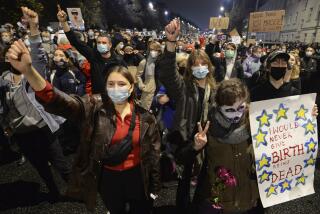Riding a Tiger in the Eastern Bloc
- Share via
Events of the past week in the Baltic states, Poland and Czechoslovakia give evidence of how profound is the upheaval that Soviet leader Mikhail S. Gorbachev has provoked. It is one that he will need to be lucky, as well as intelligent, to survive. We know that he is intelligent.
His problem is that the effort to reform an autocratic system in crisis actually tends to accelerate that crisis. Revolutions do not break out when people are suffering most and repression is worst. They come when things have taken a turn for the better and people have begun seriously to believe that there can be a real change in their lives.
Every time there has been a turn for the better in the Soviet bloc, trouble has followed. The East German uprising of June, 1953, came three months after Stalin’s death and a week after the East German government announced a “new course” with reduced work norms, more food, a halt to agricultural collectivization, etc.
The Hungarian Revolution and 1956 Polish communist mutiny against Moscow came after Nikita S. Khrushchev’s secret denunciation of Stalin at the Soviet 20th Party Congress, and after tentative East European reforms, including rehabilitation of Hungarian and Polish leaders purged by Stalin and installation of a “national communist” government in Poland.
The Sino-Soviet split and U.S.-Soviet moves toward detente, including the Test Ban Treaty of 1963, launched the liberalization in Czechoslovakia that culminated in the Prague Spring of 1968--terminated by Soviet invasion 20 years ago last week.
The Soviet government observed another sinister anniversary last week by publishing the text of the secret protocol in the Molotov-Ribbentrop treaty of Aug. 23, 1939, by which Nazi Germany assigned the three Baltic nations to a Soviet sphere of influence. They were annexed by the Soviet Union a year later. They had been free countries for the previous 20 years. Just a year ago, Soviet authorities still were denying that any secret protocol existed.
The Latvians, Estonians and Lithuanians demonstrated last week in observance of their lost independence--flying their old flags, some speakers demanding complete freedom again.
Tass said there were 100,000 people on the streets in Vilnius, Lithuania’s capital. Unofficial sources said that there were twice that number, and another 50,000 elsewhere in the country. Much the same numbers are reported for meetings in Latvia. The authorities tolerated all these demonstrations. The meeting in Estonia’s capital was organized by the “Popular Front” set up to support Gorbachev.
The Azerbaijan-Armenian crisis last spring was quieted by Moscow’s promise of a development plan for contested Nagorno-Karabakh, but the parliament of that region criticized the Azerbaijani authorities last week for dragging their feet, and new demonstrations followed.
That problem is not solved. Nothing is solved in Czechoslovakia, where the communist government emptily reigns over a stagnant economy and deeply alienated people--a people in “internal emigration.”
In Poland the government of Gen. Wojciech Jaruzelski has been successful in dividing the opposition, so that the strikes now going on have not been like those eight years ago. The Solidarity movement still has political objectives, but many strikers simply want better pay, improved food supplies, an apartment. Buying power has been steadily falling in Poland; the government itself admits that 60% of the population lives below the poverty line.
Leaders of the opposition, Lech Walesa included, understand the nature of the country’s economic crisis and the destructive effect these strikes have on the government’s attempt to pull the economy together. They simply say that the government can’t go where it wants to go unless it gives people serious reasons to cooperate and make new sacrifices. That, however, means political concessions of the kind that undermine the essential structure of the one-party communist state.
So where can it end? Gorbachev rides a tiger; predecessors have ended up inside the tiger. His great strength is that no one--not even Yegor Ligachev, his opponent on the Soviet Central Committee--sees a real alternative to the current course of reform. The Soviet leadership argues about the speed and scope of change, but no one seriously thinks it possible now to turn back. But neither the leaders nor anyone else know where this road will end.
More to Read
Sign up for Essential California
The most important California stories and recommendations in your inbox every morning.
You may occasionally receive promotional content from the Los Angeles Times.













